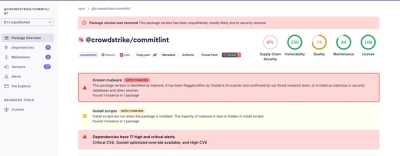
Research
Malicious fezbox npm Package Steals Browser Passwords from Cookies via Innovative QR Code Steganographic Technique
A malicious package uses a QR code as steganography in an innovative technique.
interactive is a Python 3 package that helps building interactive scripts using the full power of a Read-Eval-Print-Loop.
Use pip to install this package.
$ pip install interactive
If you have to install offline you can install it from the sources:
unzip interactive-main.zip)cd interactive-main)pip install .)If you want to include this code in your own package, just make the interactive folder available to your project scope.
Here is a small self explanatory example:
#!/usr/bin/env python3
from interactive import start, query
from interactive.expect import ExpectPredicate
start(locals()) # Initialize the context
print("Start here")
v = query(int, default=42) # give the user a REPL and wait for an answer
# the user may answer by calling `resume(some_value)`
print(f"Got v = {v} !")
sq = query( # a custom validator for the user answer
ExpectPredicate(lambda x: x == v * v, description="the square of v"),
msg="Provide the square of v",
)
print("Nice, thanks.")
The package is very simple, thus the help command should be enough to discover it.
The basic interface is made of the start, query and resume functions.
start and query are used in the script.
resume is used in interactive mode by the user to resume the script.
They are all wrapper around the interactive.context.Context methods.
A custom subclass of Context can be used for advanced control of the process.
It should be passed to start like start(locals(), Context=MyContext).
The sources is currently so simple that you can probably just go check it out.
The Expect class and its children are used to validate the data sent by the user. You may derive them and pass some instances as the type_ argument of query to provide custom validation.
The scope of the REPL is handled manually two ways.
If you want to bind to the local scope of a function, use with rescope(locals()):.
Every query in the with block will share the scope of the current function.
An example of that use can be found in samples/02_scoping.py.
If you want arbitrary scope manipulation you may use the start and stop functions.
start(some_scope) bind a new REPL to some_scope and stop() pop the last REPL from the stack.
After a start all query will use some_scope. After stop the previous scope will be restored.
start will also be used to open the top level REPL at the beginning of a script (as demonstrated above).
FAQs
Inject the full power of a REPL in your scripts
We found that interactive-script demonstrated a healthy version release cadence and project activity because the last version was released less than a year ago. It has 1 open source maintainer collaborating on the project.
Did you know?

Socket for GitHub automatically highlights issues in each pull request and monitors the health of all your open source dependencies. Discover the contents of your packages and block harmful activity before you install or update your dependencies.

Research
A malicious package uses a QR code as steganography in an innovative technique.

Research
/Security News
Socket identified 80 fake candidates targeting engineering roles, including suspected North Korean operators, exposing the new reality of hiring as a security function.

Application Security
/Research
/Security News
Socket detected multiple compromised CrowdStrike npm packages, continuing the "Shai-Hulud" supply chain attack that has now impacted nearly 500 packages.